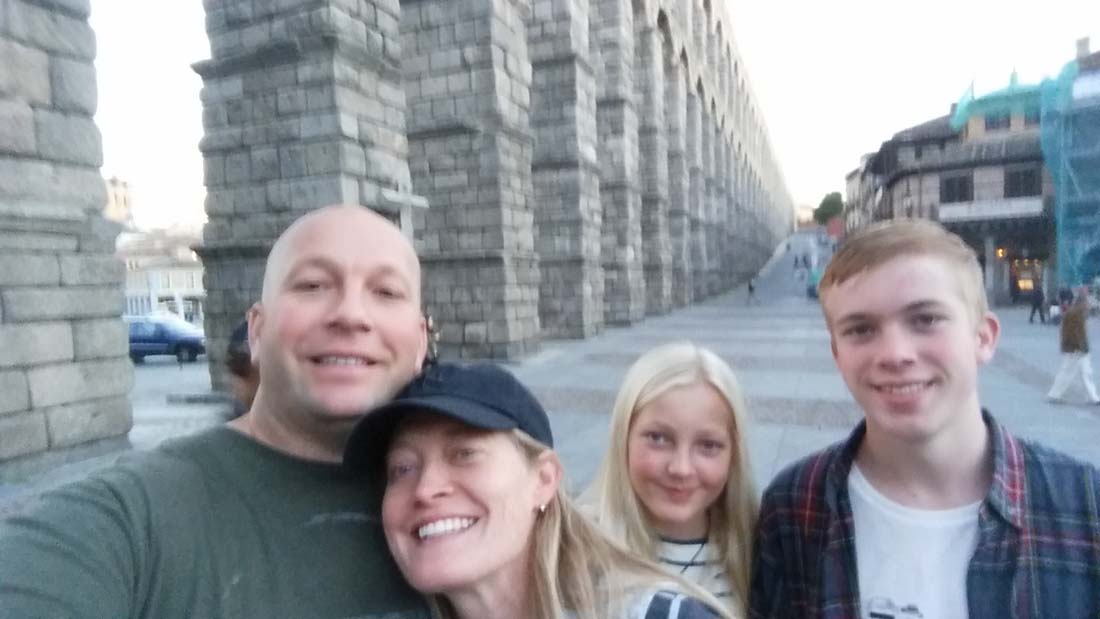 Adventuriety
Adventuriety
We spent two restful weeks recovering from our frantic Italian pace and learning the rhythms of Toledo. The call of “Lotteria!” became part of the normal sounds of the day and the Italian (ironically) owner of the coffee shop around the corner tried to teach me a few Spanish words during my daily visits for his amazing coffee creations. There were many times that I wandered lost without a map and observed day trippers carefully studying their phones or maps. Often, the people would ask which way to the walls of the city and the steps back to the parking lot that held all of the tour busses and visitors’ cars. I never really knew where I was and only toward the end of our stay could I point in the general direction of the city walls. We had been told by some people that Toledo offered only enough for a couple of days at most, but we learned that Toledo has many layers that are slowly revealed over the course of time (two weeks isn’t even that much time) and we left without seeing everything. Of course the beautiful and historically significant buildings are all around but there is much more and we were thankful to be able to slow down and soak it in. The kids loved Toledo and were sad to leave but Scott and I were ready for some adventure.
So we rented a car which always adds to the adventure. We would drive from Toledo north to Segovia to look at a Roman Aqueduct before heading to Madrid for a couple of days. There were two vehicles available in the garage at Enterprise. The kids and I wondered which one we would get.
We piled into our black VW and navigated the old fashioned way with road signs and a general idea of the direction we needed to drive. We stopped at a gas station and purchased a very dusty map from a bewildered attendant (who uses maps?) and stopped for breakfast in a random, one bar village. This is where we had breakfast and it was adventurous. We were given a menu but when we tried to order we were told that we had a choice of bacon or sausage sandwiches. So that is what we had and it was good enough. We studied our map and discussed our route. We would drive to Segovia, a little over an hour north and have an early afternoon of aqueducts, homework and dinner.
Over and over again, it is always the unplanned that is the most memorable and fun and as we drove along, I spotted a giant cross on a hilltop. We spent a lot of time hiking to summit crosses in Germany and so now crosses to us have become synonymous with hiking. The sun was shining and the summit cross was calling and so we took the nearest exit and followed the brown national park signs to our next adventure.
The price tag to get into the national park and closer to our goal was almost 30 Euros and we still had no idea what we had found. We paid the entrance fee and drove up a winding road that ended in a parking lot. We got out of the car and started walking towards the cross (we could not see the building yet) towering above us on the hilltop. We walked past a café that was open and the entrance to the funicular which was closed (for the season or permanently we did not know). We followed what looked like an access road as we searched for a trail up the hill. We could see the corner of a building and as we rounded the corner we were absolutely stunned.
What had we found along with our summit cross? We had discovered Valle de los Caidos or The Valley of the Fallen. It is a monument built by Francisco Franco to commemorate those who died in the Spanish Civil War (1936-1939). Approximately 40,000 soldiers are buried here, as well as Franco himself. In 1960,Pope John XXIII declared the underground crypt a basilica. The dimensions of this underground basilica, as excavated, are larger than those of St. Peter’s Basilica in Rome and to avoid competition, a wall was build inside the entryway and parts were left unconsecrated. The cross on the mountain top, The Holy Cross of the Valley of the Fallen, is the largest in the world standing 492 feet tall.
We thought the whole area was beautiful. The basilica and cross are set in a forest in the Sierra de Guadarrama hills. One the other side of the mountain is a Benedictine abbey which houses priests who say perpetual Masses for the fallen of the Spanish Civil War and later wars and peacekeeping missions fought by the Royal Spanish Army. The abbey ranks as a Royal Monastery.
Looking out over the valley in front of the cross.
We took a short hike and found three more crosses. We had no idea of the history of this place and so Scott started reading about the Spanish Civil War and Francisco Franco after our adventure and if you are a history buff there is a full meal and then some in this story. Valle de los Caidos is undeniably impressive and hauntingly beautiful, but much sadness, pain and controversy surround the monument even today.
Valle de los Caidos was the vision of general and dictator Francisco Franco (1892-1975) who ruled over Spain from 1939 until his death. He rose to power during the Spanish Civil War with the help of Nazi Germany and Fascist Italy. Adopting the title of “El Caudillo” (The Leader), Franco did all kinds of bad things like persecute political opponents, repress the culture and language of Spain’s Basque and Catalan regions until it almost died out, and censured the media. Hitler was even quoted as saying he’s rather spend time getting his teeth removed than deal with Franco. Restrictions gradually eased as Franco got older and upon his death the country transitioned to democracy. Franco used Republican prisoners of the war to build the monument and treated them horribly. Historical data was fabricated regarding the treatment of these prisoners and investigations are ongoing. For many Spanish, this monument only brings sad memories.
I always learn so much writing these blogs, usually about myself, the things we see, and how to spell words like medieval and aqueduct. Scott must be getting tired of hearing me go on and on about the fact that it is easier and more interesting to learn something once you are personally invested. Scott read about Franco nonstop for three days because he found the story so interesting and he told me all about it. Seriously, I would wake up in the middle of the night and he would be reading (while we were in Madrid, we were both a little nervous) and then he would start reading out loud to me. I did do some of my own research though for Valle de los Caidos and I came across a helpful little tidbit…”Visitors should not come here on Nov. 20, because the Fascists come here to honor Franco, and there has been trouble in the past.” We were there on the 19th.
We continued on to Segovia to visit the Roman aqueduct which is the most significant and best-preserved ancient monument left on the Iberian Peninsula. Let me pause for a moment and add one more item to the list of things I am learning this year: a lot more geography. After seeing, hearing and reading “Iberian this” and “Iberian that” I finally read up on the Iberian Peninsula. It is the peninsula occupied by Spain, Portugal and Andorra, separated from the rest of Europe in the north by the Pyrenees mountain range and from Africa in the south by the Strait of Gibraltar. One more thing that I learned with this blog; Gibraltar is a British Overseas Territory with a population of 30,000 people on its own little peninsula on the south coast of Spain.
Segovia a cute little town with shops, cafes, strange food and history. We stopped for a snack. I found great humor in the fartons…
…but I was overruled and we shared this yummy creation.
We walked by the cathedral and then focused on the aqueduct.
Scott had to touch the Aqueduct of Segovia which transported water from Fuente Fría river, situated in the nearby mountains eleven miles away, to the city. The aqueduct bridge was most likely built by Emperor Domitian during the 1st century AD.
We walked the length of the aqueduct. This is were the river emerged from underground and started traveling across the town of Segovia in the aqueduct.
This in the center of town where the aqueduct is at its most impressive looking towards the part of town where it begins and the mountains beyond.
Climbing the steps to the city walls and some good views.
The city of Segovia at sunset.
We spent a couple of hours exploring the aqueduct and marveling at the talent of the Roman builders. We had had a full day and were looking forward to dinner and herein lies an important lesson and one that seems to be presenting itself over and over in both Italy and Spain: be careful of local recommendations for good food. We are finding that people send you where they think you want to go, not where they actually eat. We asked for a recommendation in Segovia and ended up eating all kinds of indistinguishable food and although I am convinced that the quality was high, it was an adventure gagging down some of the delicacies, especially for Ashley. It was a good thing that we only ordered a few small plates to share and as we left to find a little something else to eat, Scott remarked that I should probably start blogging more about food since it was becoming part of our adventure here in Spain.
Comments
Comments are closed.




















Aw, this was an incredibly good post. Finding the time and
actual effort to generate a great article… but what can I say… I procrastinate a whole
lot and don’t seem to get nearly anything done.